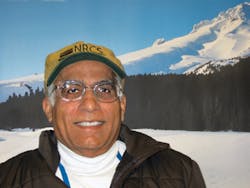Water is an essential element for sustaining life. Until recently, it was considered in some circles a natural resource of unlimited supply. However, lately the situation has changed: water has become a scarce resource around the world, including some regions of the United States, with competing interests for the limited supply. One person with a keen appreciation for this is Dr. Harbans Lal, an environmental engineer with the Water Quality and Quantity Team of the Natural Resources Conservation Service (NRCS), US Department of Agriculture (USDA) in Portland, OR. For Lal, food production is paramount to feed the world’s growing population.
Lal says, “While we have done an excellent job in increasing land productivity to meet the food and fiber demand, we have not paid enough attention to water quality and have been impacting and affecting it some cases.” He points out that agriculture is the maximum user—at 70%—of available fresh water. “At the same time, agriculture has a tremendous effect on water quality.”
To address that, Lal—as part of a USDA-NRCS scientific group—has developed a Web-based tool helping agricultural producers understand the quality of water: the Water Quality Index for Agricultural Runoff (WQIag). It provides a single number from 0 (poor) to 10 (excellent), representing overall water quality flowing off users’ fields, thus making complicated water quality data understandable and useable by non-professionals. Users input information about their field, such as slope, soil characteristics, nutrient and pest management, tillage practices, and conservation practices. It then calculates the WQIag rating. While variables such as slope and soil type won’t change, producers can adjust other factors to quickly estimate how their conservation efforts can impact water quality.
What He Does Day to Day
Lal says his daily activities center on “working on tools and technologies that can help producers do agriculture with minimal impact to the environment, principally water.” While pollution from point sources such as sewage treatment plants is regulated by the National Pollutant Discharge Elimination System, there are no such regulatory requirements on agricultural runoff from non-point sources.
Thus, NRCS bases its work on a voluntary basis, says Lal, adding, “We don’t tell farmers they have to do it. We provide options through conservation planning to help both the environment and productivity.” Lal also spends time interacting with other scientists, reviewing scientific literature, participating in webinars, writing and contemplating how he can best make use of all of the information in designing tools, techniques, and transforming scientific knowledge into a framework which can be easily implemented by the agricultural community.
What Led Him to This Line of Work
As a youth in India, Lal had not planned to go into agricultural engineering, but his academic path eventually led him to the University of Florida, where he earned a Ph.D. in agricultural engineering. For more than 40 years, Lal has worked in natural resources management, specifically in agricultural systems worldwide, including India, Brazil, and the US. He’s also done private consulting work for many federal agencies. “I keep telling my supervisor I have limited time left on this planet, but I want to make a significant impact in the profession.”
What He Likes Best About His Job
Lal derives satisfaction through interacting with professionals worldwide. He enjoys working on water-related problems that could alleviate human suffering. He appreciates the freedom of planning his day to perform tasks. His positive supervisory evaluations support that as long as he is making contributions to the overall USDA/NRCS mission. “It’s satisfying if I have contributed something significantly in the professional arena,” he says.
His Greatest Challenge
Transforming complicated scientific knowledge into something the layperson comprehends in such a way where its real value is not lost is Lal’s biggest challenge. Because of the ‘green revolution’ that enabled agriculture “to do whatever farmers wanted as long as there was high crop production and high yield, we’ve gotten used to using water and nutrients to keep the highest crop yield, not the optimum crop yield,” says Lal. “There is pressure to feed the growing world population, but at the same time, we have to maintain our environment, including water, for future generations.”
Carol Brzozowski specializes in topics related to resource management and technology.
